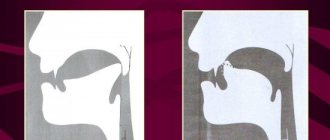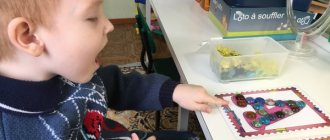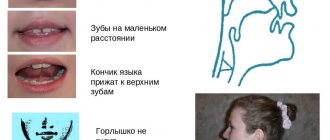Types of sound violations [Р] and [Рь]
- No sound.
The sound is devoid of its inherent articulation, as evidenced in speech by the lengthening of the adjacent vowel. - Replacing sounds
(pararotacisms) with other sounds. - Distortions of sounds (rhotacism).
Types of rhotacisms:
velar
- the tongue does not take part in articulation, the soft palate vibrates.
The pronunciation resembles the French [P]; uvular
- it is not the tongue that vibrates, but the uvula (small tongue);
nasal
– a combination of sounds [N] and [G] is heard;
lateral
– a “squelching” sound is heard;
buccal
– when exhaling, the cheeks swell;
coachman
- closed lips vibrate;
bilabial
- the sound is similar to English [W];
single-impact
- the tip of the tongue does not vibrate, but only hits the alveoli once. - Mixing sounds
- more often [P] and [L]; [Ry] and [L]; [P] and [Y]; [Rb] and [Y].
Sound setting [P]
Shmakova Elena
Sound setting [P]
Setting the sound R
Normal setting when pronouncing a hard sound “R”
is this:
— The tip of the tongue is raised to the palate, the lateral edges are pressed against the upper molars. Under the pressure of exhaled air passing through the middle of the tongue, the tip of the tongue vibrates at the alveoli.
Preparatory exercises
To generate air pressure:
- Taking air into your lungs, blow forcefully (not just exhale)
him, causing his lips to vibrate. Blow out the air while turning on your voice.
For language
- Clicking, clicking your tongue. Click your tongue at a variable pace so that its entire mass first sticks to the palate for a moment and then falls down. The distance between the teeth should be at least one and a half fingers, the lower jaw is motionless during the exercise.
— Raise the tongue to the palate, stretching the “frenulum”
.
The distance between the teeth is one and a half to two fingers. Hold your tongue in the upper position for up to 6 seconds. Articulatory gymnastics for producing the sound R
“Swing”
- Smile, open your mouth.
Move the tip of the tongue into a “one-two”
from one corner of the mouth to the other. The lower jaw remains motionless.
"Painter"
- Smile, open your mouth. Using the wide tip of your tongue, stroke the palate from the teeth to the throat. The lower jaw should not move
“Brushing the upper/lower teeth”
- Smile, open your mouth slightly.
Using the tip of your tongue, “clean”
the upper/lower teeth from the inside, moving the tongue left and right.
"Harmonic"
- Smile, open your mouth.
Suck your wide tongue to the roof of your mouth. Lips in a smile. Without lifting your tongue from the palate, open and close your mouth. “Drum”
- Smile, open your mouth.
the sound “d-d-d”
repeatedly and clearly . In this case, the tongue rests on the upper teeth, the mouth does not close. Tap out different melodies in this way. Like on a drum. Perform the exercise with your voice as quickly as possible
"Machine gun"
- pronounce
the sound [d] in the same way as in the previous exercise, imagining how a machine gun scribbles: [d-d-d].
Pronounce with force, on one exhalation, with your voice. "Fence"
- Teeth clenched, lips stretched into a smile.
"Tube"
- lips in a tube, teeth closed.
Alternate with “Fence”
“Mushroom”
- mouth open, tongue to the roof of the mouth, pull it towards the sky.
"Wave"
- smile, mouth open, tip of tongue resting on lower teeth
Techniques for producing the sound R
1. Open your mouth and pronounce the sound “ddd”
at a fast pace, rhythmically.
In this case, the tongue should not close with the incisors, but with the gums of the upper incisors or alveoli. When repeatedly pronouncing a series of sounds , blow strongly on the tip of the tongue, causing vibration.
2. Pronounce the sound “zh”
without rounding the lips and moving the anterior edge of the tongue slightly forward, towards the gums of the front teeth or alveoli.
The sound is pronounced with significant air pressure.
At this time, a spatula is inserted under the tongue and rapid movements of the spatula to the right to the left cause vibrations of the tongue. During training, the exhaled stream should be strong. 3. You can also put the sound “r”
from the syllabic combination
“zzza”
.
In this case, the tongue should be at the alveoli, the mouth should be slightly open. While pronouncing, insert a spatula and quickly move it from side to side. At the moment of vibration, a fairly clear sound “r”
.
You can cause the tip of your tongue to vibrate in the following way: with your mouth open, try sucking your tongue to the roof of your mouth, then, without letting go of your tongue, blow on it.
At the moment the tongue is lifted from the palate, a strong push of the exhaled stream of air causes a short vibration of the tip of the tongue. This exercise reinforces the feeling of vibration of the tip of the tongue, and then you can cause this sound yourself , without mechanical assistance.
The second version of the same method (with mechanical assistance)
.
Raise your tongue to the sky, stretching the “frenulum”
.
Then, with your thumb and index finger, press the lateral edges of the tongue firmly against the palate. The middle part of the tongue and the frenulum
should remain unclamped.
Taking a deep breath, forcefully blow out the air while turning on your voice. The tongue “swells”
and
the sound combination tzh (some children immediately get the combination tr (dr)
.
Repeat the exercise many times, gradually increasing the air pressure. The sound combination tzh will gradually turn into tr (dr. Be sure to ensure that the tip of the tongue vibrates and is held against the palate, and the edges of the tongue are adjacent to the lateral edges of the upper teeth. Under the pressure of a strong stream of air, a short tr-tr (dr - dr)
.
The following inaccuracies may occur: fingers grasp the “bridle”
, and there is no vibration when blowing air;
the air does not pass along the tongue, but into the nose, so the tongue does not “swell”
or
“pop”
;
insufficiently strong stream of exhaled air; instead of the sound combination tr (dr)
, tl is heard, this means that the tongue itself works voluntarily (work, that is, vibrate, the tongue should be under the pressure of a strong stream of air, the tongue should fit tightly to the palate and be motionless; one should refrain from
making sound r by imitation ...
a sound is pronounced correctly, the tip of the tongue vibrates, and when imitation is incorrect, very often either the “tongue”
, or the root of the tongue in contact with the soft palate.
After fixing the pronunciation of the short tr (dr)
it is necessary to train rolling long tr
(dr)
- first with the help of fingers, and then without fingers.
There is no need to rush at any of these stages. You may get a rolling r the first time, but it may take several months.
Attention!
In some cases, it is believed that to produce the sound r (less often sh, zh)
It is necessary to trim the hyoid ligament (
“frenulum”
).
However, this is unnecessary. The reason for the absence of the sound p is the weakness of the muscles of the tongue and the underdevelopment of the “frenulum”
, so the tongue is not able to rise and press against the palate.
Experience shows that after a complex of speech therapy massage of the tongue or special exercises, the muscles of the tongue develop, and the “frenulum”
stretches, and there is no need to trim it.
To help with the exercises, you can stretch the hyoid ligament with a special massage.
Sound Pь.
After automating p, using the technique of imitation, the correct pronunciation of p is achieved. If necessary, you can practice the upper zz, zz, zz, pronounced repeatedly and then for a duration. A long, rolling r is successively combined with the vowels i, i, e, e, yu, while stretching the lips into a smile. Having achieved the correct pronunciation of ry in syllables, words are introduced, etc.
The main task you face is to perform these exercises regularly, preferably every day.
Having started staging in one way , do not rush to be disappointed in it and move on to another. Please be patient with this work.
1 way to set the sound [P] : Setting [P] - quickly and efficiently. This method helps to quickly create vibration. The child puts his head on the speech therapist’s lap, sucks his tongue to the roof of his mouth ( “Fungus”
, at this time the speech therapist, with his thumb and forefinger
(clean),
presses the lateral edges of the tongue to the palate (not the tip, the child blows forcefully on the tongue and...often vibration appears immediately!
Method 2 of making the sound [R] : The child is asked to raise his wide tongue behind his upper teeth and pronounce a sound similar to “zzh”
(you hear something in between these
sounds : [z] with an overtone [zh] or vice versa ) or pronounce the sound [d] (but the tongue is not near the teeth, but on the alveoli, so the sound [d] is not clear ).
3rd way to make the sound [P] : Make sure that the tongue is wide and very tense. At this time, straight (cleanly washed, with the nail cut short so as not to scratch the tongue)
Using the child’s index finger or your own finger wrapped in a handkerchief placed under the tip of the tongue, make frequent oscillatory movements from side to side, causing a rumbling
sound . (You can use a pacifier tightly stuffed with cotton wool or make a plastic spatula from a toothbrush, removing the bristles to create a comfortable plastic stick; the corners must be rounded.) When the child’s hand gets used to it and the tongue does not slip off the finger (spatula), the baby will be able to cause vibrations of the tongue. If the tongue is not wide and not tense, the finger will carry it along with it and there will be no trembling. The tongue will swing along with the finger, with a sound close to “dl"
... Pay special attention to the child that the tongue should be like a steadfast tin soldier and under no circumstances leave his
post . You can compare the tongue to a string. If the string is taut, then by touching it we cause it to vibrate, the string begins to sound, but if the string is loosened, there will be no sound . This exercise is very children like it, and they do it with pleasure. The child can be told that you are now going to try to start the engine. Having achieved vibration of the tip of the tongue with mechanical assistance, the duration of vibration is lengthened and gradually moves to the fact that the child begins vibration with mechanical assistance, and continues without it . Over time, it is enough for the child to bring his finger to his mouth, and the tip of the tongue begins to vibrate on its own (the finger in this case serves as self-soothing, the child is not yet confident in his abilities, gradually the need for this disappears. If independent vibration of the tip of the tongue is not produced for a very long time, they begin to automate the sound [p] in syllables and words, achieving a roll with mechanical assistance.
4th method of setting the sound [P] : You can cause vibration of the tip of the tongue as follows: invite the baby to suck his tongue to the palate with his mouth open, then, not releasing the tongue, blow on it. At the moment the tongue is lifted from the palate, a strong push of the exhaled stream of air causes a short vibration of the tip of the tongue. This exercise reinforces in the child the feeling of vibration of the tip of the tongue, and then he can cause this sound independently , without mechanical assistance. The second version of this same method (with mechanical assistance)
.
Raise your tongue to the sky, stretching the “frenulum”
.
Then, with your thumb and index finger, press the lateral edges of the tongue firmly against the palate. The middle part of the tongue and the frenulum
should remain unclamped.
Taking a deep breath, forcefully blow out the air while turning on your voice. The tongue “swells”
and
the sound combination “tzh”
(some children immediately get the combination
“tr” (dr)
. The teeth in the exercise are open at a distance of one and a half to two fingers. Repeat the exercise many times,
gradually increasing the air pressure. The sound combination “tzh” will gradually turn into “tr”
(dr. Be sure to ensure that the tip of the tongue vibrates and is held against the palate, and the edges of the tongue are adjacent to the lateral edges of the upper teeth. Under the pressure of a strong stream of air, a short
“tr-tr” (dr. )
.There may be the following inaccuracies: the fingers grab
the “frenulum”
, and vibration when blowing air does not work; the air does not pass along the tongue, but into the nose, so the tongue does not
“swell”
and does not
“pop”
; the stream of exhaled air is not strong enough; instead
the sound combination “tr” (dr)
is heard
“tl”
, this means that the tongue itself works voluntarily (work, that is, vibrate, the tongue should be under the pressure of a strong stream of air, the tongue should fit tightly to the palate and be motionless; one should refrain from
making the sound [r] by imitation . When a sound , the tip of the tongue vibrates, and when imitation is incorrect, very often either the “tongue”
or the root of the tongue in contact with the soft palate begins to vibrate.
After consolidating the pronunciation of the short “tr” (dr),
it is necessary to train the rolling long
“tr” (dr)
- first with the help of fingers, and then without fingers.
There is no need to rush at any of these stages. A child may get a rolling r the first time, and it may take several months. The main task you face is to perform these exercises regularly, preferably every day. Having started staging [p] in one way , do not rush to be disappointed in it and move on to another.
Please be patient with this work. 5th method of setting sound [P] : Setting from sound [Z] . Usually R is not placed from the sound Z , since it is believed that they are very different in articulation and cannot be a reference for each other. But you can try. The secret is that the child pronounces [Z] very briefly, only touching the alveoli with his tongue and at the same time blowing strongly on the tongue. At first, a single-strike [P] will be clearly heard, which then relatively easily turns into vibrant. This method is very easy and fast, especially with throat [P]. I wish you success in using it!
6th method of making the sound [P] : For progeny: press the tip of the tongue to the lower incisors and pronounce the vowel “ААААА”
, alternately opening and closing your mouth.
With the mouth closed, the child will place the upper incisors on the tip of the tongue pressed against the lower incisors, i.e. the child will tap the top of the tongue . When classical techniques for setting [P] are not enough .
7th method of setting the sound [P] : In especially persistent cases, when the classical methods of setting [P] are not enough , I use the following exercises - syllables that must be pronounced quickly and rhythmically: dydydydydydy....adydyadydy....tydydydydydy. dydadydadyda...adydaadadyda...youydydydydydy.... dydodydodydo... dydoadydo...
8th method of making the sound [R] : Games-exercises for producing the sound [R] . The exercises are very simple and are well suited for training the raising of the tongue to the alveoli, and at the same time trains fine motor skills. a) Exercise “Happy Rain”
Pronounce firmly
the sounds [t-d] . Do you hear as if droplets are falling and hitting something hard? Place your left palm and show with your fingers how raindrops fall on your hand, slowly at first, and then faster and faster. The rain dripped onto the palm - t-d, t-d... (with your right hand, depict falling drops of rain)
On the flower - t-d, t-d
(with your left hand, depict a flower)
And on the path, t-d, t-d....
(make a path from your left hand)
He knocked on the roof - t-d, t-d….
And there was a frequent ringing - t-d, t-d, t-d (the rain started getting heavier)
.
While playing, try to change hands and learn the rhyme by heart. We pronounce T-D exaggeratedly (emphasized)
.
We exclude the work of the jaw. b) Exercise “Crocodile Gena’s Song”
The melody of the song is well suited for training the raising of the tongue to the alveoli.
At first we sing the song only on the syllable YES. In the future it will be useful to use the syllables DY, DE, DO, DU. You can alternate syllables, taking into account the child’s wishes. When fixing the sound [r], we sing a song on the syllable RA.
9th method of setting the sound [P] : Setting [P[ from the interdental position. The “tongue on the upper lip” position is preliminarily practiced.
and directed air stream.
• Wide edge of the tongue on the upper lip. In this position, the child is asked to blow on the tip of his nose with a buzzing sound similar to “B-B-B”
.
• In addition to the previous position, the speech therapist uses his index finger to “play”
on the child’s lower lip, as a result of which the air stream acquires a vibrating character.
This effect needs to be worked out properly. Older children can be offered independent “performance”
with a finger on the lip.
• Then gradually reduce the duration of the finger touch, then removing it, then returning. Achieve a vibration sound from the slightest touch on the lower lip (something similar to “v-v-r-r-e-uh...”
) • Keeping the same configuration of the tongue, while the vibration sound is being developed, it is easy to move the tongue behind the upper teeth. It is important not to lose the shape of your tongue! This technique was taken from the arsenal of Irina Anatolyevna Smirnova, a speech therapist from St. Petersburg. She recommended it for children with dysarthria, since in this case the child does not require great muscle effort, and, therefore, the spasticity of the articulation organs does not increase.
10th method of setting the sound [P] : Setting the sound [P] while inhaling . The condition is the correct and clear pronunciation of the sound [C] . The child pronounces SSSSS for a long time, and then takes a short breath through the mouth, sharply raising and pressing the tongue to the alveoli, sucking the tongue “like a snail into a shell.”
.
If the child does not touch the alveoli with his tongue when inhaling, then the sound will not be produced . The method is very unexpected, paradoxical (after all, all normal speech therapists make sounds “on exhalation”
)
11th method of setting the sound [P] : Setting the sound [P] from the exercise “CHATTER”
.
There is an interesting playful way of making the sound [P] from the exercise “Chatterer”
, which is well known to children.
The method is accessible to any beginning speech therapist. The child does the exercise “Chatterer”
(or
“Turkey”
): sticking out a wide tongue on
the sound [A] performs movements back and forth, sliding along the hard palate. At the moment when the tongue touches the alveoli, a single-beat [P] is heard. Now all that remains is to fix this position and start automating [P]. As a rule, very soon the single-beat sound itself turns into vibrant (the tip of the tongue trembles)
.
12th method of setting the sound [P] : Setting [P] from the sound [F] . Everything new is well forgotten old. Method of setting [P] , actively used 30-40 years ago. All speech therapists love to evoke the sound [R] using all kinds of vibrations ( “motor”
and the like).
But there are children who are terrified of probes, sticks, pacifiers, teaspoons and other improvised means. The following method is very good for them: the child pronounces the sound [F] , for a long time, on one exhalation and at the same time moves the tip of the tongue deeper into the oral cavity. A second later you can hear a single-beat [P]. After fixing the isolated pronunciation of this sound , they immediately move on to pronouncing syllables with a combination of TR, DR, NR, ZHR. This contributes to the rapid transfer of a single-beat [P] into a state of vibrating sound .
The method justifies itself. 13th method of making sound [P] : The method of making sound [P] is as old and simple as the world. Performed in 3 steps: 1) suck the tongue to the hard palate ( “Fungus”
) 2) take a deep breath through the nose
(tongue in the same position)
3) make a sharp short exhale through the mouth, directing the air stream to the tongue and connecting the voice.
It would take a long time to describe all this, but the method is very simple. The effect is achieved by contrast (tongue tension during suction and relaxation during sharp exhalation)
. This helps cause vibration in the tip.
14th method of setting sound [P] : Setting [P] when there is insufficient air flow. The method is suitable for those children who do not have an air stream of sufficient power necessary to vibrate the tip of the tongue. It is based on the traditional method of placement using a ball probe. And the peculiarity is that the child is in a semi-lying position, with his head slightly thrown back. The tongue is raised up towards the alveoli, the child pronounces the sound [D] or the combination DY at a fast pace. The probe makes quick movements under the tip of the tongue to the right and left. The effect is achieved by the fact that in the supine position the tongue is slightly pulled back and the child is forced to exhale a stream of air more intensely, which starts the vibration in combination with the manipulations of the probe.
For throat r, I use the following method if the child has the sound z . I start with the fact that we are learning to say the combination j. This helps the child form the correct pattern for further pronunciation of the sound p . “machine gun” exercise at this stage.
(we pronounce dddddddddddd, I hold the edges of the tongue at the top on both sides with my fingers. Then, when the tip of the tongue gets stronger and gets used to the correct position, I use the
“motor”
. After
setting the sound, I move on to automating it.
Sound automation .
sound r is obtained , it is very carefully introduced into the words. Having become accustomed to throaty pronunciation, the child cannot always control his articulation. Therefore, self-control and control by an adult are necessary for a long time.
Causes of impaired pronunciation of “vibrants”
Produces a strong and long-lasting air jet
An important role for setting the sound [P] is played by the correct setting of fixed breathing.
A strong, targeted air stream should pass through the articulatory organs. This means that you need to teach your child to breathe and speak correctly at the same time. Often this is not so easy to do. With the help of the following series of exercises, you will understand how to correctly position your tongue followed by the development of a targeted air stream in the middle of the tongue: 1. Place your tongue in the “Pancake” position (see description above) and blow forcefully on it with your voice turned on. When the air vibrates, the tongue will vibrate.
2. “Snowflake”: place a small piece of cotton wool on the tip of your nose and take a deep breath through your nose. Place the tongue in the “Spoon” position (see description above). We press our tongue to the upper lip and forcefully exhale air from the mouth onto the tip of the tongue. A piece of cotton wool should fall off your nose.
3. We bring a scrap or piece of paper to our nose and aspirately pronounce the sound [D]. When pronouncing each sound [D], a piece of paper should be shaken by a strong stream of air.
Interesting facts about the letter P
What is interesting is that in the Old Church Slavonic language this letter could be both hard and soft, and sometimes even a syllable-forming unit. Another interesting feature and mystery of the “R” is that the sounds for the letter “r” are so dissimilar that if necessary, you will have to memorize all these different letters “r”.
It is interesting that this letter itself carried not only a semantic load, but also an emotional vibration, a certain psychological message personifying the power of vibrations and/or energies.
If we take into account the two main languages of the European part of the world, we can trace the trend of two developments of the letter “r”. It is either pronounced distorted or not pronounced at all. Where it came from and how it appeared is one complete mystery!
The letter “r” gained particular fame thanks to the French language. There, two varieties of a given letter can simultaneously exist: anterior lingual and uvular. The front-lingual letter “r” is no different from our ordinary letter “r”, while an example of uvular sound is French speech and its soft, palatal, slightly burred pronunciation.
An interesting fact is that they begin to realize a special relationship to this letter as children grow up. The most common reason for turning to specialists is the production of this particular sound in early childhood.
Children often do not understand how to master this obstinate sound, replacing it with the easier to pronounce “l”. But everything is simple! You just need to know the entire articulatory structure, consisting of the position of the lips, tongue, and soft palate.







